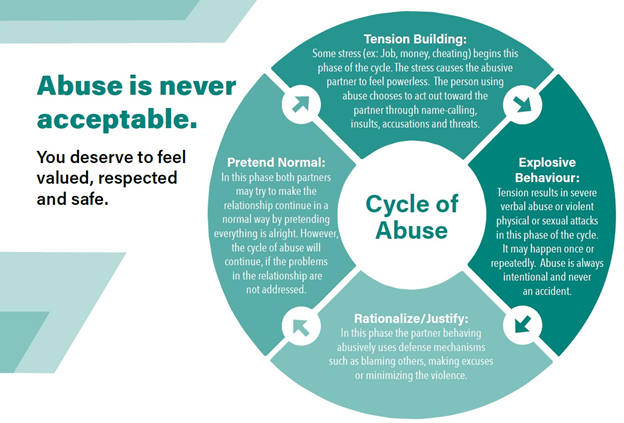Understanding Intimate Partner Violence and How to Move Forward
Intimate partner violence (IPV) can happen among heterosexual and 2SLGBTQ+ partnerships. It occurs within all age ranges, ethnic backgrounds and economic statuses. Although it is more common for women to experience abuse, men also experience abuse. IPV affects everyone in the family. Children exposed to IPV are more likely to develop behavioural problems and may grow up to think that violence in an intimate relationship is acceptable.
Abuse can be verbal, emotional, psychological, sexual, physical or financial. While physical injury is dangerous and scary, the emotional and psychological consequences of domestic abuse are also very serious. Emotionally abusive relationships can destroy one’s feelings of self-worth and self-confidence and possibly lead to anxiety and depression. Physical health problems can also develop from living with severe stress and anxiety that come from being in an abusive environment.
Intimate Partner Violence may occur on a continuum and may change over time.
In most cases, abuse does not occur all the time. The abuser’s actions in between episodes of abuse may make it difficult to seek help. The abuser may make you believe that things will be different or that you are the only person who can help them. The first step in breaking free is recognizing that your situation is abusive and getting the help that you need.
Signs you are in an unhealthy relationship:
Inner Thoughts and Feelings
Do You:
- avoid certain topics to avoid conflict?
- justify abusive behaviour that occurs in your relationship?
- feel emotionally numb or helpless?
- not trust your partner?
Controlling Behaviour
Does your partner:
- act excessively jealous or possessive?
- keep you from seeing friends or family?
- limit your access to money, the phone or car?
- constantly check up on you?
- minimize the abuse?
- have rigid ideas of the roles of men and women?
- want control and access to your phone, email, social accounts, and/or bank account?
Violent Behaviour or Threats
Do you or your partner:
- have a bad and unpredictable temper?
- hurt or threaten to hurt or kill?
- threaten to remove the children or have them harmed?
- hurt or threaten to hurt or kill pets?
- destroy the other’s belongings?
- use technology to post false and/or hurtful information online?
Belittling Behaviour
Do you or your partner:
- humiliate or yell at the other?
- criticize or put the other down?
- treat the other so badly you are embarrassed for friends and family to see?
- ignore the other’s feelings?
- put down the other’s opinions, values or beliefs?
Abuse is never O.K. You deserve to feel valued, respected and safe.
Sometimes abusive behaviours present themselves gradually, over time and sometimes are hard to recognize as abuse. The Cycle of Abuse can help you understand how behaviours and events fit together.

Violence and abusive behaviour is a deliberate choice made by an abuser to control a victim. Abusers may use the following to exert their power:
Intimidation: Threatening looks or gestures.
Threats: May be used to scare someone from leaving or in an attempt to get ones way. Threats may also be made in the heat of the moment during an argument.
Aggression: Can be towards an individual or object. Someone behaving abusively may push, hit, kick, and/or choke their partner. They may also break, punch or smash objects when angry.
Humiliation: Includes degrading and belittling. This can make someone feel worthless, powerless and alone. This behaviour can occur in private or public.
Isolation: This involves a person being limited from connecting with friends or family, or cut off from the outside world.
Manipulation: Using guilt or attempting to make a partner feel ‘crazy’.
The choice to leave or remain in an abusive relationship is complex and personal due to various reasons:
- you love your partner
- you hope things change
- you don’t believe your partner’s actions are abusive
- you are financially or physically dependent on your partner
- you don’t know where you would go or how you would function without your partner
- you are isolated from those who could help
- your cultural, religious or family expectations do not allow you to leave your relationship
- you blame yourself for your partner’s abusive actions
- you are worried or fearful about what will happen if you leave your partner
- you are worried about what will happen to your children when they are in your partner’s care if you are not there
If you recognize yourself or someone you know in this situation, reach out. There is help available. Contact Victim Services for more information.
| Manitoba | Toll Free: | 1-866-484-2846 |
| Winnipeg Region | Winnipeg: | 204-945-6851 |
| Interlake-Eastman Region | Selkirk: | 204-785-5213 |
| Central Region | Portage la Prairie: | 204-239-3378 |
| South-Central Region | Morris: | 204-746-8249 |
| Westman Region | Brandon: | 204-726-7400 |
| Parkland Region | Dauphin: | 204-622-5080 |
| Northern Region | The Pas: | 204-627-8483 |
| Thompson Region | Thompson: | 204-677-6368 |
More Resources
Understanding Intimate Partner Violence and How to Move Forward

